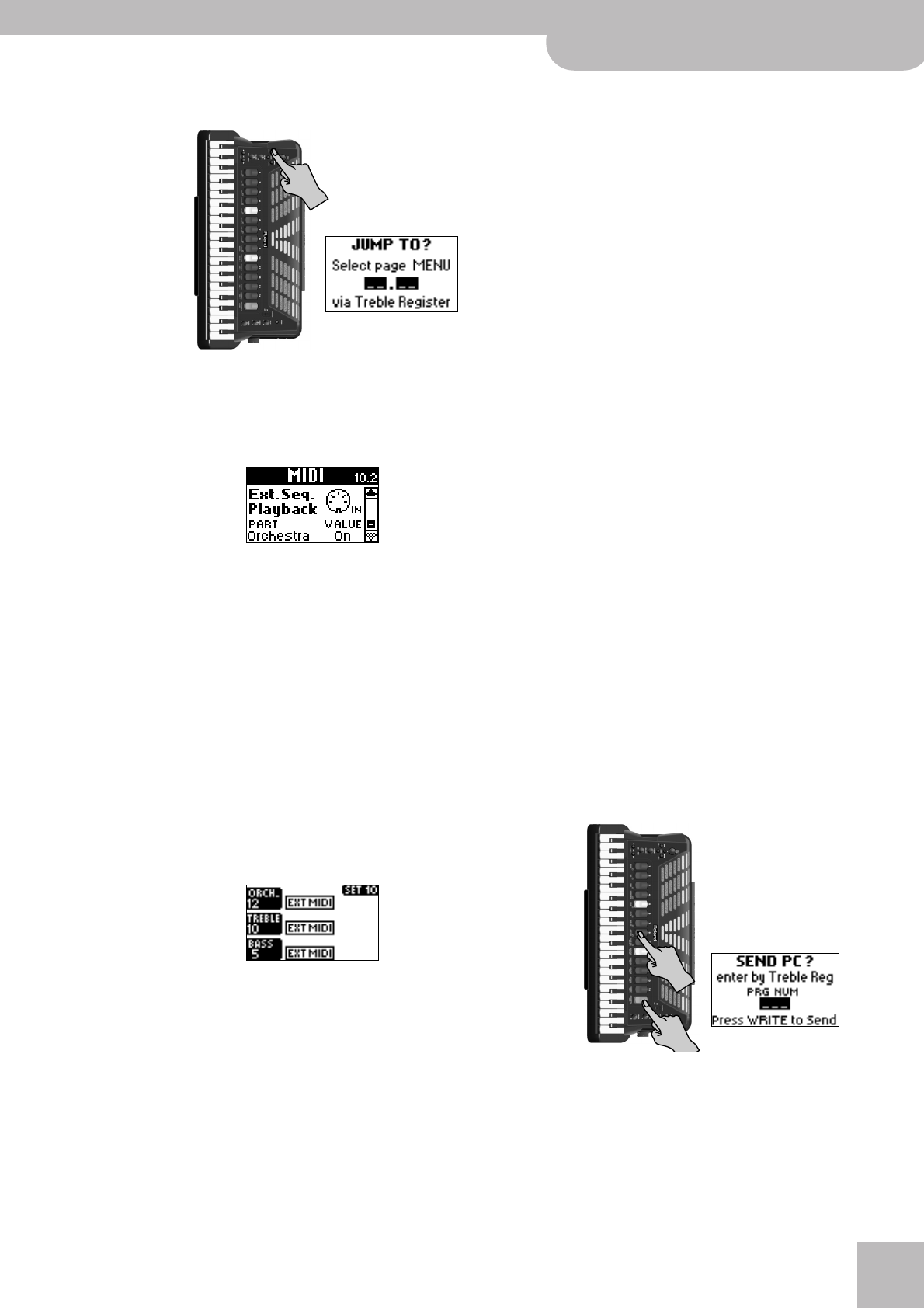
Sending program change messages when necessary
V-Accordion
r
83
(1) Press and hold the [EXIT÷JUMP] button until the
display looks as follows:
(2) Press register [12] to specify the function group.
The “Ext. Seq. Playback” parameters can be set via a
parameter of the “MIDI” group, which is why you
need to select that group.
(3) Press register [2] to select the following page:
(4) Press the [DATA÷ENTER] knob to select “PART” (left
entry), then turn it to select the part whose setting
you want to change.
The parts you can select here are: “Treble”,
“Bass&Chord”, “Orchestra”, and ALL”. Select “ALL” to
change the status (also called “Local” in the MIDI
world) of all available sections.
Note: “ALL” can also be selected from the Main page by simul-
taneously pressing the [ORCHESTRA÷MODE] + [1] registers.
Note: The “Bass&Chord” entry also includes the Orchestra
Chord and Orchestra Free Bass sections.
(5) Press the [DATA÷ENTER] knob to select “VALUE”
(right entry), then turn it to select “On” (disconnect
the part from the internal tone generator) or “Off”
(normal operation).
A part you disconnect from its keyboard is flagged as
“EXT. MIDI” on the Main page:
(In this example, all sections are disconnected from
the FR-7/FR-5’s tone generator, which is probably a
highly unlikely configuration.)
Note: When you select “On”, the FR-7/FR-5’s registers no
longer transmit the sound selection clusters you may have
programmed using “CC00, CC32, PC” on p. 87. Instead, they
transmit their “Std” values.
(6) Press [EXIT÷JUMP] to return to the Main page.
(7) See “Saving your changes” on p. 82 if you want to
save these settings.
If you don’t save them, they are reset when you
switch off the FR-7/FR-5.
Sending program change messages when
necessary
(12.4 Bank for ‘Send PC’)
Though each register can transmit a program change/
bank select cluster when pressed (see “CC00, CC32, PC”
on p. 87), you can also transmit sound select messages
on the fly – without changing registers on the FR-7/
FR-5. These are MIDI messages that cause an external
instrument or device to select a different memory (i.e.
another sound or effect).
This functionality is mainly intended for selecting set-
ting groups of various sounds on external instruments.
Such setting groups may be called “Performances” or
“Multis”, which you may want to select while playing,
because working with “finished” Performances, etc.,
does away with the need to program sound select
addresses for the FR-7/FR-5’s registers (see “CC00,
CC32, PC” on page 87). Using those multitimbral mem-
ories has the advantage that all sound addresses and
MIDI channels are configured “automatically” simply by
sending the correct “PC” address from the FR-7/FR-5.
As the first half of the name (“Send PC”) suggests, this
function only transmits messages to an external device
whose MIDI IN port is connected to the FBC-7’s MIDI
OUT socket.
Here is how to take advantage of that function:
(1) Connect the FR-7/FR-5 to the FBC-7, and the
FBC-7’s MIDI OUT socket to the MIDI IN port of the
module, synthesizer, etc., you wish to control.
(2) Set the module’s MIDI receive channel (often
called “RX”) to “13”.
See its manual for details. If you are unable to
change the receiver’s MIDI channel, set the FR-7/
FR-5’s “Control Ch” to match the external instru-
ment’s “RX” channel. (See “MIDI channel numbers” on
p. 81 for how to set the “Control Ch” parameter.)
(3) Hold down the [ORCHESTRA÷MODE] register while
pressing register [8].
(4) Use Treble registers [1]~[10] to enter the sound
number.
You may have to look in the owner’s manual of the
module or synthesizer you are controlling to find
out which number you need to transmit for the
sound (or memory) you want to select. You can
enter any number from “1” to “512”.


















